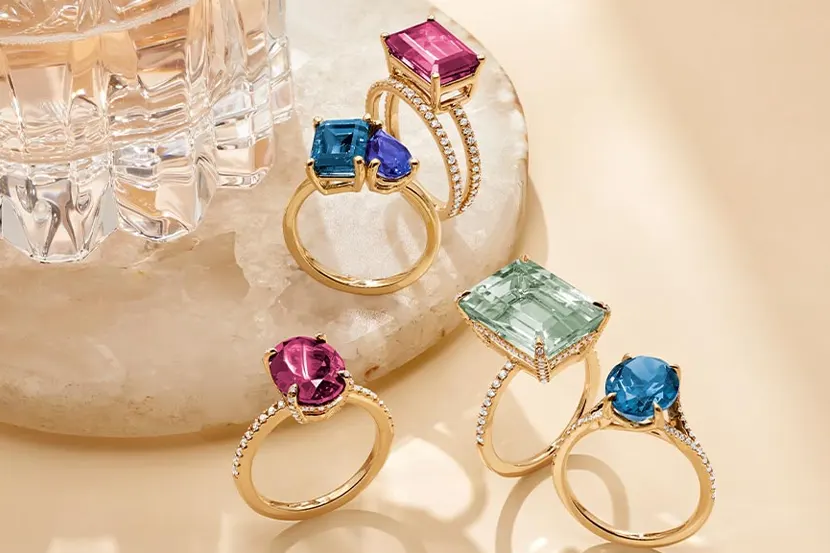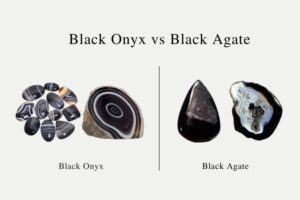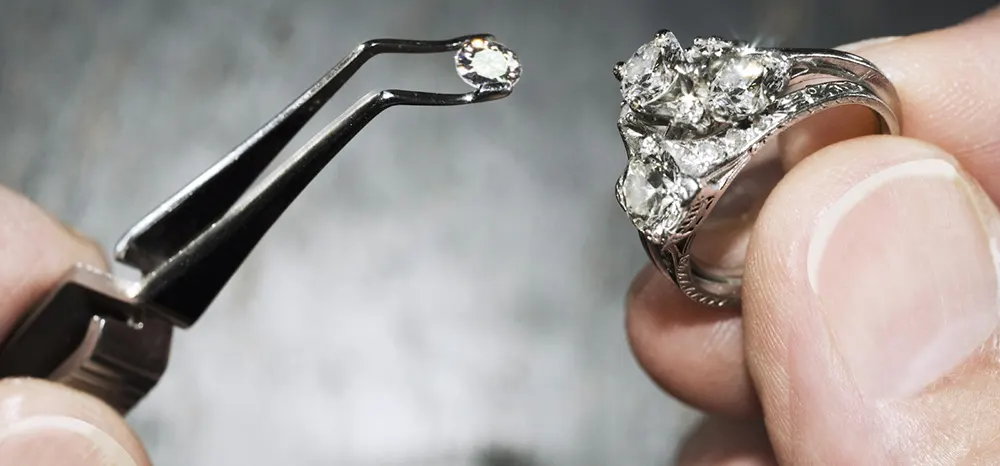
A variety of complex manufacturing processes are used to create gemstone jewelry. Gemstone jewelry offers a classic, elegant appearance. But as someone who enjoys wearing gemstone jewelry, have you ever wondered how these lovely pieces are made? Why are some products labeled “handmade” while others aren’t?
This article provides informative as well as educational insight into all these questions and offers even more. So buckle up as we take you through the world of gemstone jewelry manufacturing.
Design & 3D Modeling
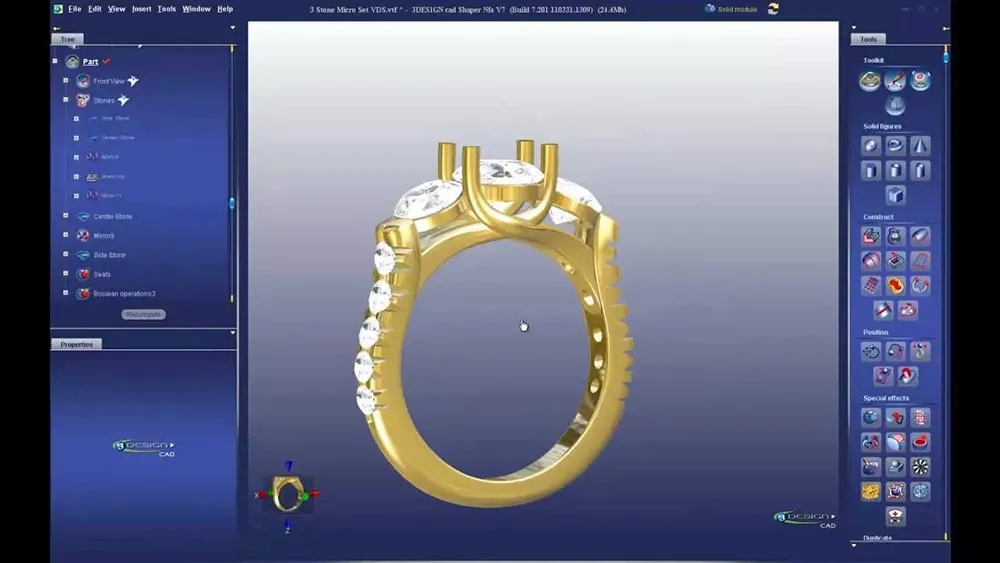
This is the first step in gemstone jewelry creation. It involves an initial conceptualization of an idea, then printing a prototype, which is then used in fashioning the jewelry. A computer may also be used in the creation of 3D models for designing any shape or material. This is known as a CAD model.
A CAD model, or “computer-aided design,” is a three-dimensional computer model of an object. CAD models are used in the jewelry industry to design jewelry of any shape, material, or size. In addition to being an important part of the modern jewelry production process, CAD files are used in many other design-oriented industries, such as architecture and engineering.
CAD files in 3D design modeling
To put it simply, a CAD file is utilized to create a wax model that is then 3D printed and cast in a precious metal. Since developing and creating a wax model by hand is much less efficient than using 3D printing, the jewelry industry has started to adopt this new technology over the past few years.
Prototyping/Sampling
In this context, a prototype or sample refers to a display model. That is, a mock-up or replica of what the buyer can expect to obtain when purchasing a specific design.
Ring and Chain
A ring is a circular band that is typically constructed of metal and worn as decorative jewelry. The word “ring” by itself always refers to jewelry worn on the finger; when it refers to an ornament worn on another body part, such as earrings, neck rings, arm rings, or toe rings, the body part is mentioned within the phrase. Rings can be produced from any material that is impervious to daily wear and maintains its shape, but as jewelry, they are frequently made from corrosion-resistant precious or semi-precious metals. Rings are most commonly used to represent a relationship between two people, such as an engagement or wedding ring. For those who are not yet engaged or for friendship, other sorts of rings may be worn. The left ring finger is usually (although not always) used for rings that are connected to engagement or marriage. Rings may also have gemstone inclusions. The classic stone choice for wedding and engagement rings is diamonds. However, people may decide to opt for other precious or semi-precious stones for reasons such as affordability, personal preference, or the various symbolic connotations associated with specific gemstones.
Chains
Chains are a type of jewelry that consists of a succession of links connected together to make a lengthy line. Depending on the style, these links may appear differently. Chains are made up of smaller components that are connected together in a sequence.
Chains are often made of sterling silver or gold and can be styled in a variety of ways. Chains’ versatility and applicability are possibly two of the most defining characteristics that set them apart from other types of jewelry. Just like rings, they can be worn on many body parts, such as the wrist, neck, and ankles. Chains have been around for so long that there are numerous unique alternatives to choose from.
Chains are also frequently worn with gems set as a center figure or at several locations along the chain.
Most Common Gemstones
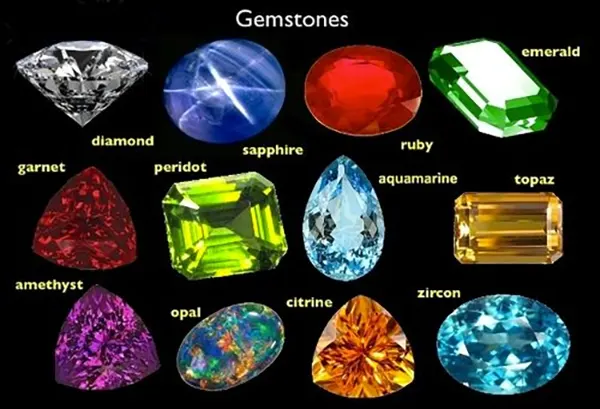
Alt text: various types of common precious and semi-precious stones
A gemstone is any mineral that is treasured for its beauty, durability, and rarity. Gemstones are known by a variety of names. You may hear them referred to as jewels, gems, stones, precious stones, and semi-precious stones. Gemstones are as varied in color and composition as they possibly can be, and they are largely of inorganic origin (the only one of organic origin being pearls).
Here is a list of the most popular gemstones, along with a brief description of each.
- DIAMONDS:
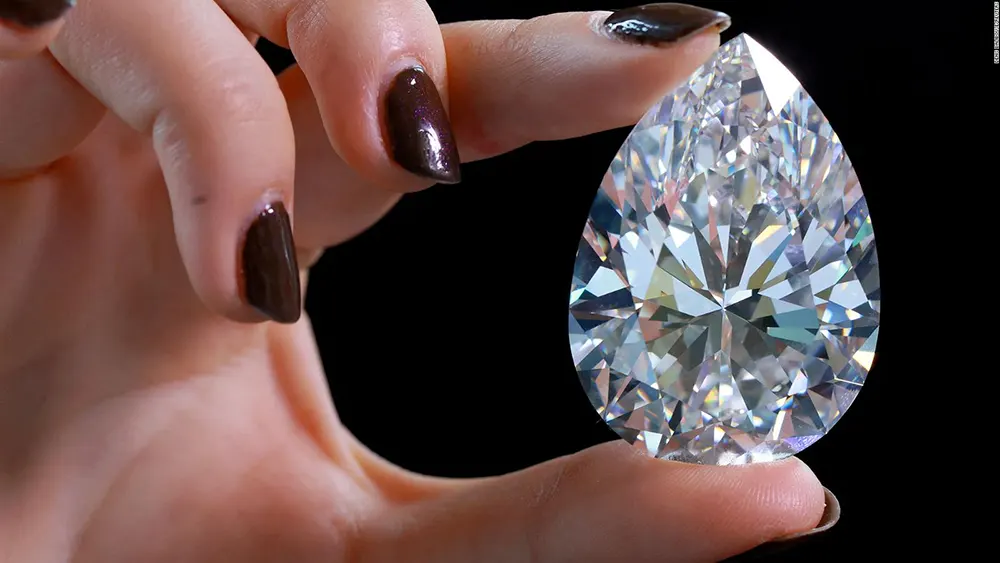
A diamond is a typically colorless mineral composed of pure carbon. It is the hardest naturally occurring substance in nature. Diamonds are famous for their incredible sparkle and high refractive index. Diamonds are unparalleled at the apex of the gemstone market due to their exceptional durability, brilliance, and rarity.
- Moissanites:
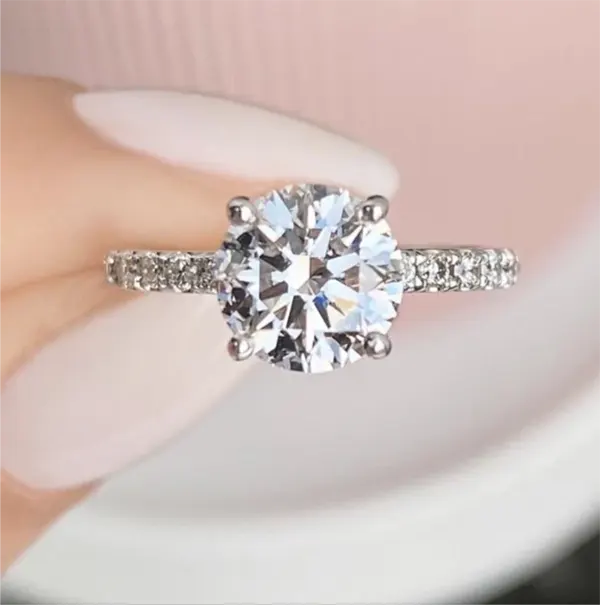
Moissanite is a naturally occurring mineral composed of silicon carbide. According to Don O’Connell, president and CEO of Charles & Colvard, the original creator of moissanite, “moissanites are so rare that they can’t be found in quantities large enough to be cut into a one-carat gemstone.” As a result, moissanite obtained from the market is typically lab-grown.
Moissanites are the perfect diamond substitute; not only are they far more affordable, but they also share similar characteristics in terms of hardness and sparkle. For example, while diamonds have a rating of 10 on the Mohs scale of hardness, moissanites have a rating of 9.25, making them the second-hardest naturally occurring mineral. In terms of sparkle, most gemologists agree that moissanites have more fire and brilliance than any other gemstone, including diamonds.
- Zircon crystals:
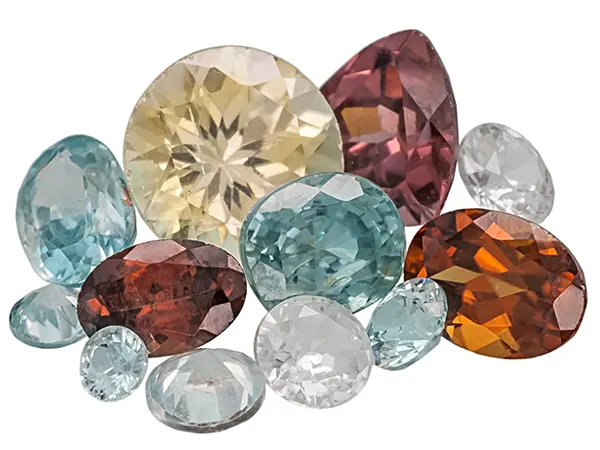
Zircon is a well-known mineral that is available in both colored and colorless forms. Its chemical name is zirconium (IV) silicate (ZiSiO4). Zircon is another gemstone that shares a close resemblance to diamonds. Though not nearly as resilient as diamonds (7.5 on the Mohs scale of hardness), zircons have a shine and sparkle that is optically similar to what is obtained in diamonds.Zircons are also fairly abundant, so they are normally mined rather than created in a lab. The display of double refraction in zircons is one way to easily distinguish zircons from diamonds, as diamonds do not exhibit this property.
- Cubic zirconia:
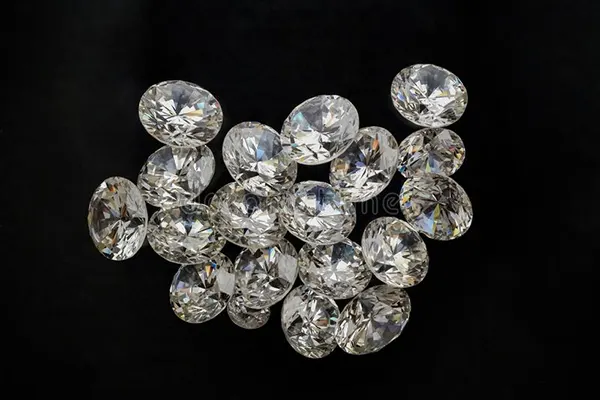
Cubic zirconia is perhaps the most popular and certainly the cheapest diamond simulant. Cubic zirconia are lab-grown minerals whose chemical name is zirconium dioxide (ZnO2). As a result of the controlled environment in which these gems are created, they are usually eye-clean and free of inclusions that cloud natural diamonds. Cubic zirconias bear a close resemblance to zircon crystals; however, they are more sturdy (having a rating of 8.5 on the Mohs scale of hardness). A property that differentiates cubic zirconia from real diamonds is thermal conductivity. While diamonds are exceptionally good conductors of heat, cubic zirconias are thermal insulators.
Based on their rarity, gemstones are classified as either precious or semi-precious.
Precious Gemstones
There are four types of precious gemstones. They are:
- Diamonds
Diamonds have been discussed in detail above.
- Emeralds
Emeralds are precious gemstones obtained from the mineral beryl that have been colored green by trace amounts of chromium and, in some cases, vanadium. Emeralds have a rating of 7.5 to 8 on the Mohs scale and typically contain several inclusions.
- Sapphires
Sapphires are a gemstone variety from the mineral corundum. They exist in various shades of blue. Sapphires are primarily made of aluminum oxide mixed with trace amounts of elements such as titanium, iron, vanadium, chromium, or magnesium. Sapphires are very hard and durable, with a hardness level of 9 on the Mohs scale.
- Rubies
Just like sapphires, rubies are another gemstone variety from the mineral corundum. Rubies come in various shades of red, from pinkish red to blood red. They have similar chemical compositions, and both have the same Mohs hardness rating (9). Rubies are significantly rarer than sapphires, making them more expensive.
Semi precious gemstones
These gemstones are so-called because they are more easily obtained in nature. The list of semiprecious stones is lengthy and exhaustive. As a result, only a few will be listed here. Alexandrite, agate, amethyst, aquamarine, garnet, lapis lazuli, moonstone, opal, pearl, peridot, rose quartz, spinel, tanzanite, tourmaline, turquoise, and zircon are some popular examples.
Gem Stone Cutting
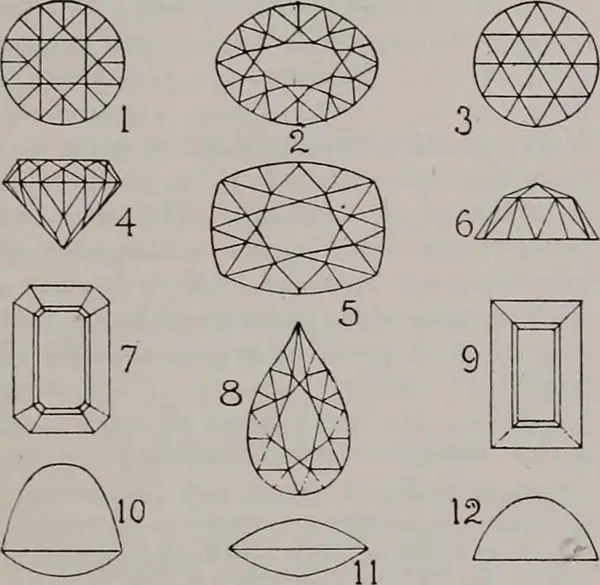
Gemcutting or lapidary are terms used to describe the process of cutting and polishing gemstones, while a person who does the actual cutting or polishing is called a gemcutter or lapidarist.
There are three basic styles used in gemstone cutting today. In this section, the three basic styles of gemstone cutting will be examined, along with their features and how lapidarists combine them to produce different, unique gem designs.
While some cut names may refer specifically to the shape of the finished gem, others refer to the shape and arrangement of the gemstone’s facets. As a result, finished gemstones can be named by combining their face-up shape with the gem cutting style used in their manufacture. For example, in Image 1, the gemstone is “round brilliant” because of its spherical shape and its brilliant cutting style.
The three basic gemstone cutting styles are: brilliant, step, and mixed.
Brilliant cut
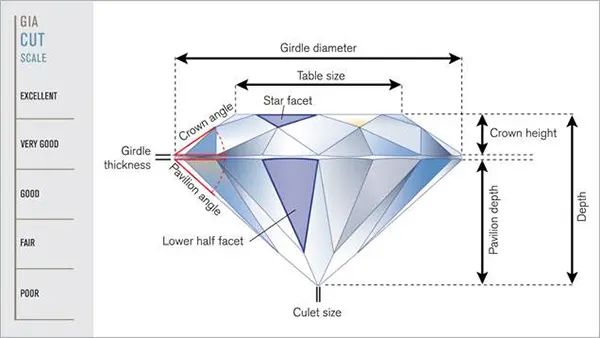
A brilliant cut is a process of faceting a gemstone that maximizes the optical qualities of the stone to produce a finished gem with maximum fire and scintillation.The most common type of gemstone faceting is the brilliant cut. The form resembles a cone and optimizes light return via the top of the stones. A brilliant cut, according to scientific designation, reflects the majority of the light, and it makes the best use of the optical qualities of gemstones to produce maximum fire and brilliance. The most common brilliant-cut round gemstone has 58 sections, whereas a high-quality brilliant-cut diamond can have over 200 sections. A brilliant-cut gemstone will be more expensive than another gemstone of similar weight and quality due to its difficulty in fabrication and greater usage.
Step cut
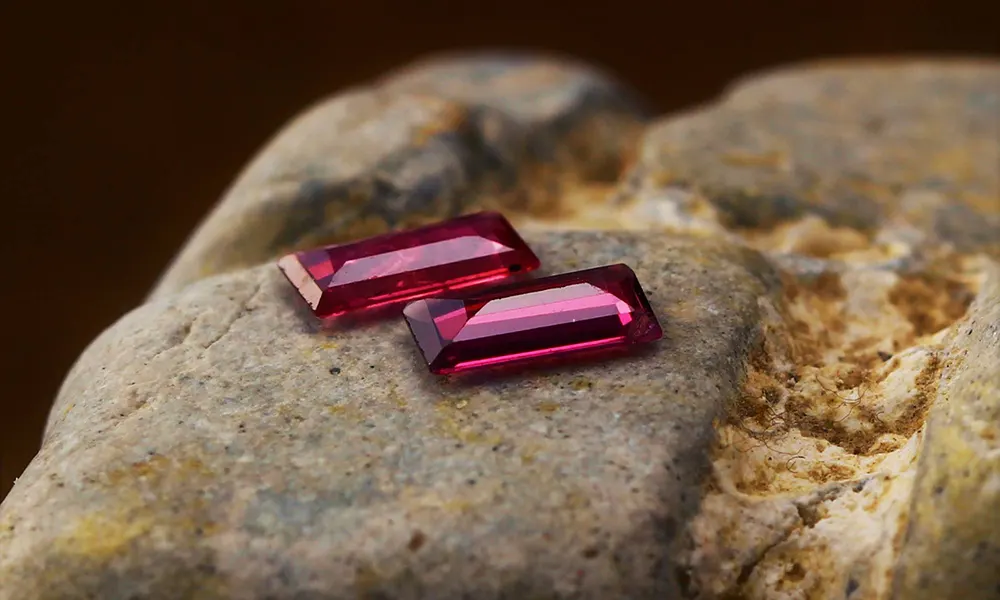
A step cut, which is also called a trap cut or cushion cut, is a gemstone cut with either a square or rectangular shape and facets that are positioned parallel to one another. The name derives from the arrangement of the facets, which appear larger than those of a brilliant-cut gemstone and resemble steps. Emerald and baguette cuts are examples of step cuts. These are popular because they highlight the color and clarity of the stone while producing a delicate sparkle. A step-cut gemstone is typically less expensive than a brilliant-cut gemstone of similar weight and quality.
Mixed cuts
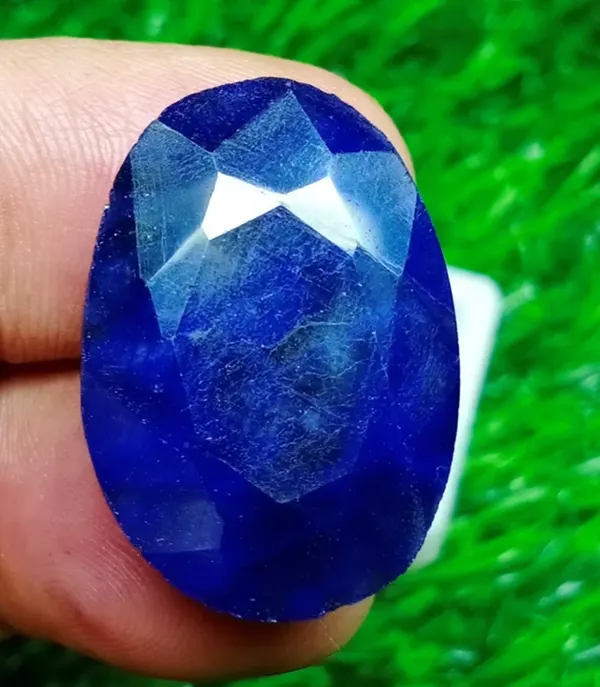
Alt text: mixed-cut natural blue sapphire
A mixed cut gemstone faceting style is simply a combination of brilliant cut and step cut gemstone faceting styles. They have brilliant crown facets and step pavilion facets, or vice versa. A very popular example of a mixed cut is the radiant cut, which has an elongated outline typical of step cuts and a brilliant-cut surface to make it dazzle.
Other, less familiar examples of gemstone cutting styles include:
- Rose cut
- Ceylon cut
- Briolette cut
- Barion cut
- Cabochon cut- a smooth, domed gemstone with no facets is called a cabochon cut. It is more typically found in opaque or translucent stones to highlight distinctive characteristics such as asterism or color play. This gemstone cut style is also the best selection for soft gems like the moonstone, which could be easily damaged during the process of faceting.
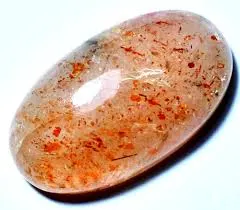
Alt text: cabochon cut natural orange sunstone:
- Baguette cut
- Checkerboard cut
- Scissor cut
- Portuguese cut
Gem Stone Setting
The phrase “gemstone setting” refers to how a gemstone is securely affixed to a piece of jewelry. While there are many different kinds of gemstone settings, some are more common than others. Those more common examples will be reviewed in this section to acquire a thorough understanding of what gemstone setting is all about. The goal of gemstone setting is twofold: first, to secure the gem to the jewelry, and second, to enhance the beauty of the jewelry item and the brilliance of the gem.
Without further ado, let’s examine some of the most common types of gemstone settings for rings, necklaces, and bracelets.
For rings
1) Prong/claw setting
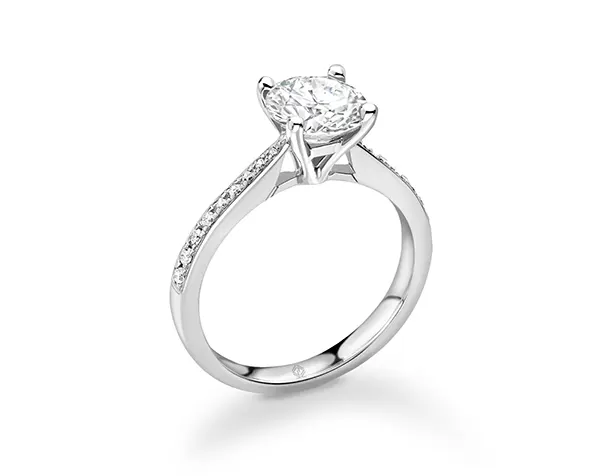
Today, prong settings are the most popular style of gemstone setting. This is because they enable a lot of light to penetrate the back of the stone, causing it to glitter nicely while also firmly holding the gemstone. A prong setting is traditionally made up of four prongs. However, there are numerous variations of the prong setting based on the size and shape of the stone. As for the design of the prong, there are numerous possibilities, ranging from round or squared tines (prongs) to v-shaped ones for gemstones with pointed corners.
Prongs are commonly used for faceted stones because they permit more light to enter. Prongs are not exactly ideal for pearls because they can scratch them as they move around. In order to avoid movement, jewelers typically glue the pearl into the setting.
2) Bezel setting
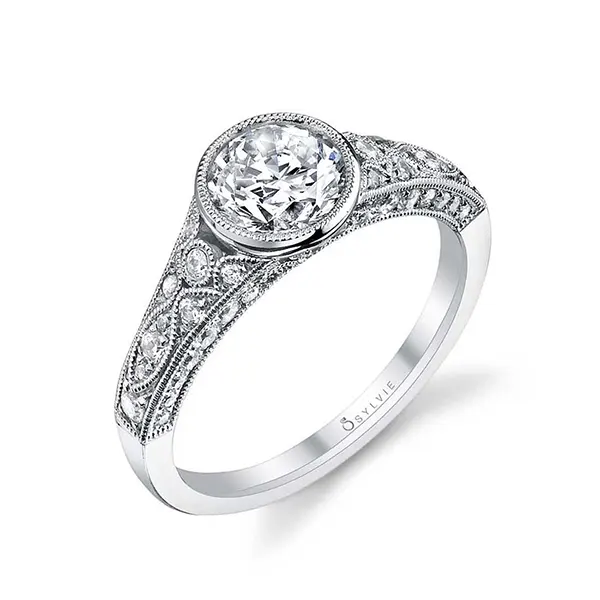
Bezel settings are one of the most secure gemstone settings you can find today. In a bezel setting, the metal wraps around the stone, and the only view of the stone that can be obtained is the bird’s-eye view. This has both positive and negative implications for the stone. The good side is that the stone is less likely to fall out of the setting and has added protection from scratches. This is of much greater importance in softer gems like pearls and opals, which have a hardness rating that is less than 7 on the Mohs scale of hardness. The disadvantage of this setting is that it does not allow as much light into the stone as other settings. As a result, colored stones seem darker, significantly reducing their aesthetic appeal; this also diminishes diamond brilliance.
The bezel setting is mostly used for cabochons (polished stones with no facets), but it is also a great choice for faceted stones and diamonds. This setting is especially effective for masking flaws around the margins of less-than-perfect gemstones.
3) Tiffany setting
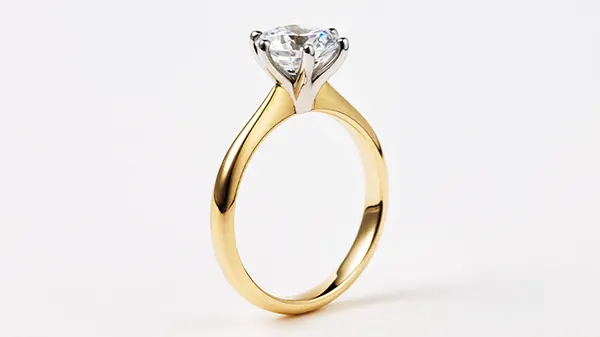
The Tiffany setting is a newer variation of the prong setting. It puts more distance between the gemstone and the body of the ring. This shows off the ring more and permits better light entry, allowing the stone to really sparkle.
4) Trilogy setting
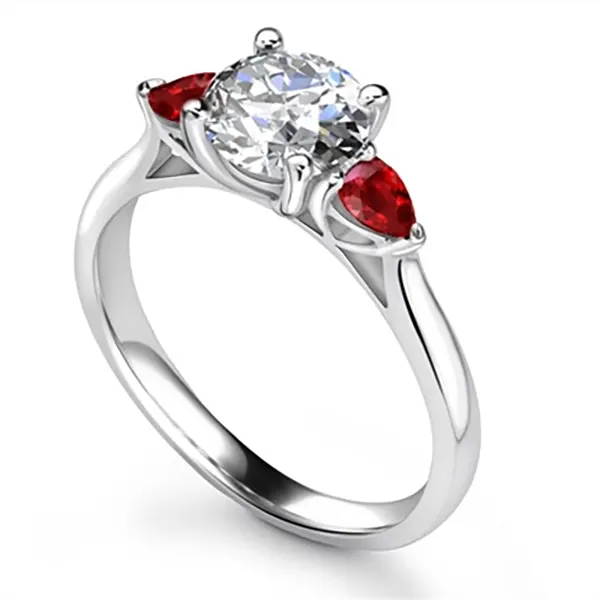
The trilogy setting is a popular setting design, particularly for engagement rings. This setting style permits full flexibility in its placement in jewelry. Options include:
- Three stones identical in size and shape
- Three different-shaped stones
- Large center stone with smaller outers of either the same or different shapes
This makes it much easier to create a customized item because it all depends on the size, shape, and type of stones used in the piece.
5) Cluster setting
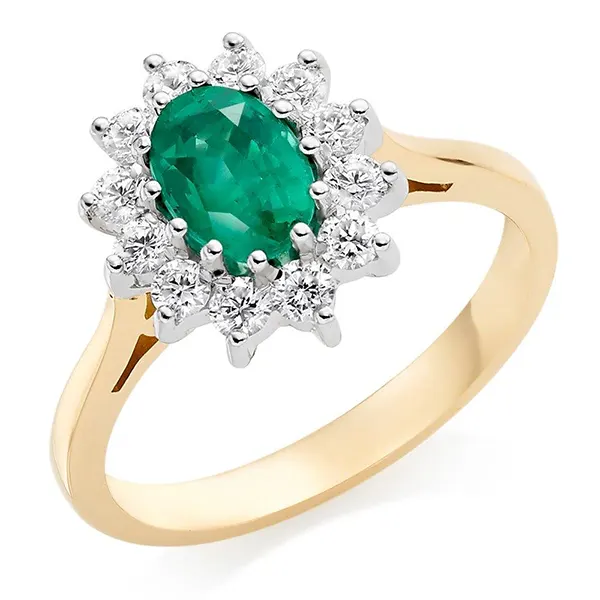
Clusters are often composed of tiny diamonds that surround a larger stone. Because the diamonds in the cluster are so much smaller in size, they make the stone they’re surrounding appear considerably larger. An engagement ring is a popular jewelry option for locating the cluster setting. This form of engagement ring is highly popular with folks who choose a colored gemstone, such as a ruby or sapphire, as the center stone as opposed to a diamond.
For bracelets and necklaces
Sometimes the distinctions between bracelets and necklaces are not so obvious in the designs given to them. Most necklace designs, for example, usually have a similar design as a matching bracelet. However, when pendants are in the equation, there is a little bit more difference in their designs and gemstone settings because pendants used in bracelets (charms) are quite different from the ones traditionally used in necklaces.
Most gemstone settings go well with engagement rings; thus, the settings listed here not only look great on necklaces and pendants but are also a nice fit for rings as well.
1) Tension setting
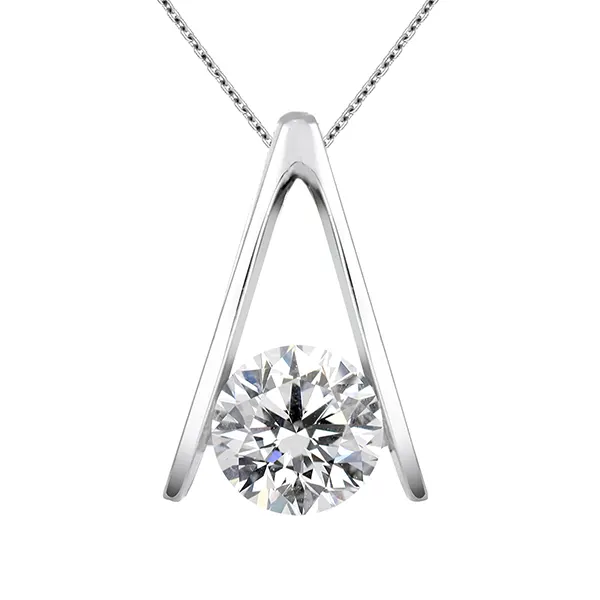
The tension setting is an aesthetically pleasing style that can be found in every item of jewelry. It provides the impression that the stone is floating in space within the jewelry. It does come at great risk to the jewelry, though. The traditional tension setting isn’t known to be very secure because, over time, the tension within the metal holding the stone starts to reduce, which can result in the stone falling out. Many jewelers and designers have sought to mitigate this by incorporating a connecting support bar between the two sides of the pendant (or ring) in the case of a necklace.
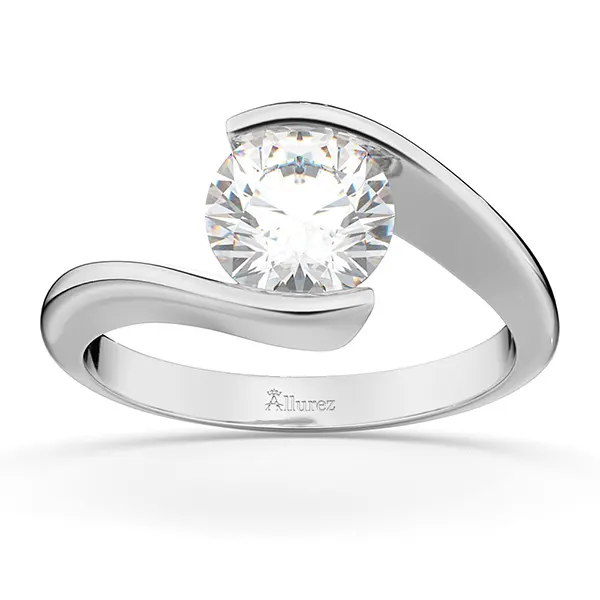
2) Flush/gypsy setting
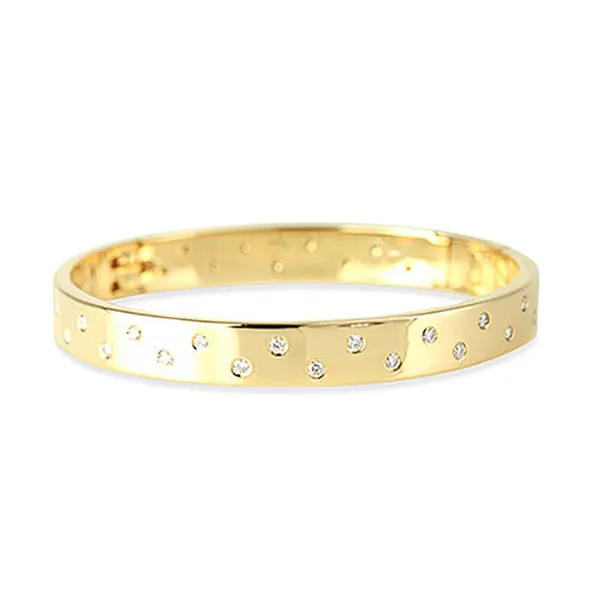
Alt text: gypsy set diamond bracelet
The flush or gypsy gemstone setting is a great style for bracelets and rings, not so much for necklaces, though. It is also sometimes known as “burnishing.” In this type of stone setting, holes large enough to house the stones are drilled into the surface of the metal. The stones are then inserted, after which a burnishing tool is used to push the metal around them. The stone will be level with the surface, with a burnished or rubbed edge surrounding it. This setting is very secure, as the stones are held in place by the metal that has been pushed over them.
3) Pavé setting
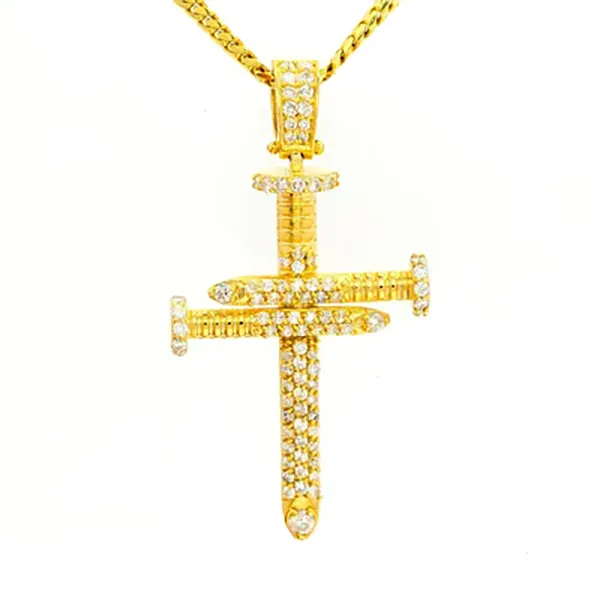
The pavé setting is a well-known style for setting small diamonds into necklace pendants and bracelets, and in recent times, engagement rings. The French word “pavé” means to cover a surface, typically with stones (by laying cobblestones close together). In jewelry, this is commonly accomplished with diamonds. A pavé piece is one of the most challenging gem settings to manufacture. Only the best jewelers are capable of doing it well. In this setting, the jewelry maker drills holes slightly smaller than the diameters of the gems’ girdles into the metal and then places the stones inside these holes. Next, small prongs of gold are raised and pressed over the girdles of the gems using a V-shaped chisel. The end product is a magnificent piece of jewelry with stones that reflect light in multiple rows or columns and resemble several little prong settings.
4) Channel setting
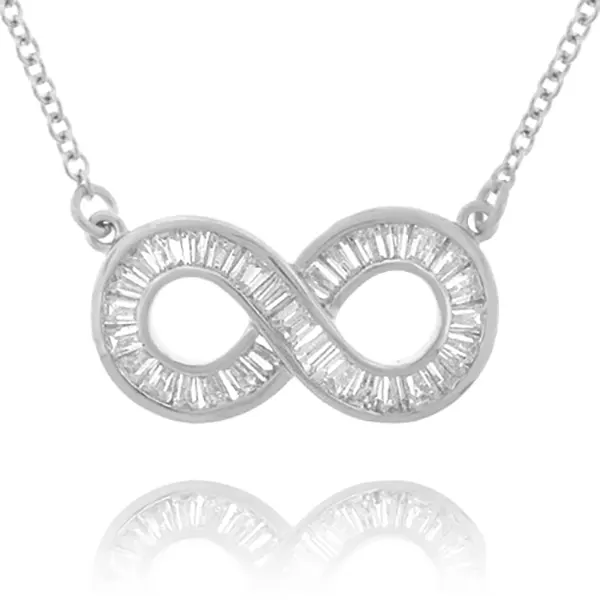
The channel setting is a very popular style for eternity rings and tennis bracelets. Channel setting is a technique in which stones are suspended between two metal frames or strips called channels. Instead of a separate set of prongs for each stone, the stones are placed into the channel and held in place on each side by a continuous strip of metal. The stones are positioned girdle-to-girdle along the groove and fixed by hammering the channel walls’ upper sides. Channel settings are suitable for a wide range of faceted stones. However, for all its beauty, this setting is not as secure as other types of settings, and gems are prone to falling out. This can, however, be rectified by placing sufficient metal both within the band and around the stones to ensure maximum security.
5) Halo setting
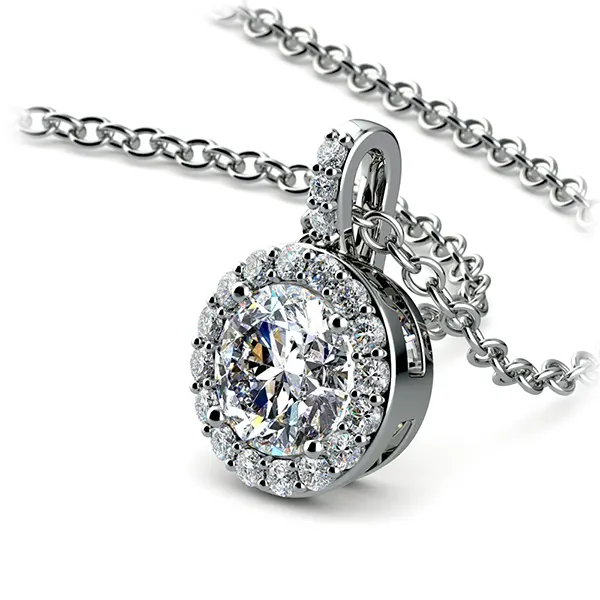
The halo setting is appropriate for use as a necklace pendant as well as setting stones within a ring. It is a more contemporary take on the traditional cluster setting that uses smaller stones to create a pattern around a large, centrally placed stone and, as a result, more brilliance. The stones in a halo setting are pavé set because this style, with its prong-placed stones, allows a lot of light into the stones, causing them to sparkle brilliantly. Although practically any type of stone can be used in the halo setting, round and oval-cut center stones are the most popular.
Quality Control
Quality control is a set of processes and procedures to ensure that a product’s quality is maintained and improved against a set of standards and that any faults detected are either eliminated or decreased. The goal of quality control is to verify that the product and its manufacturing are not only reliable but also meet the expectations of the consumer. It brings consistency to the process. Most enterprises have a quality control department that establishes the standards that must be met for each product. To determine whether the items produced match these requirements, either a local team or an outside party is recruited.
When it comes to gemstone jewelry quality control, there are a few factors to be considered, and the purpose of this section is to serve as a consumer’s guide to gemstone quality grading. The factors to be considered are collectively known as the “Four C’s” of gem grading.The four attributes used to grade gems are color, clarity, cut, and carat (weight). These characteristics are used by gemologists to grade gemstones.
Color
Gemologists often refer to gemstone color by splitting it into three distinct components or elements: hue, tone, and saturation.
Hue
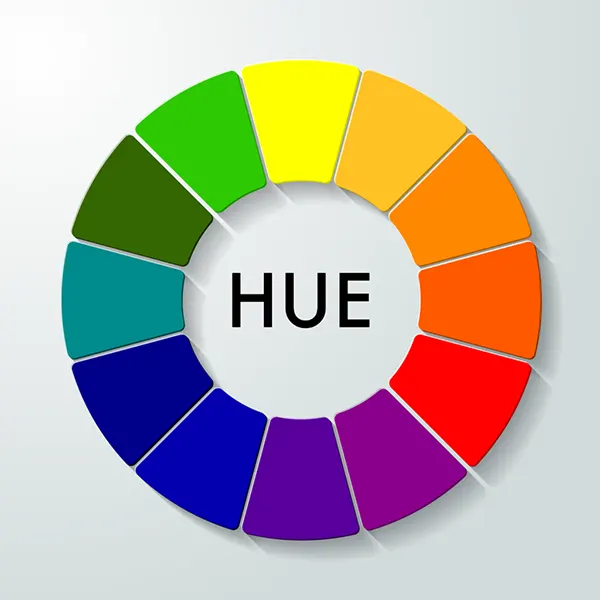
Independent of tone or intensity, hue serves to describe the stone’s general color. Basic hue examples include red, green, blue, etc. Among colored gemstones, those with rich, vivid colors and flawless hues command the greatest prices.
Any indication of color influences the value of colorless gems like diamonds, and those with no color are the most expensive. The GIA’s diamond color-grading scale is the industry standard. The scale starts with the letter D, which stands for colorless, and progresses to the letter Z, which stands for pale yellow or brown.
Tone
The tone of a gem relates to its relative lightness or darkness. Tones go from darkest to lightest in black and white. Thus, black and white are more correctly referred to as tones than as hues. “Tint” and “shade” are both terms used to refer to tone. Tint can be used to describe lighter tones, while shade can be used to express darker tone levels. Each gem variety has an appropriate tone. Stones that are too dark or too bright will lose value as they deviate from the “optimal” tone.
Saturation
The saturation of a gem describes how intense the color is. Colors might be bold or delicate. Pink is red with minimal saturation. Warm hues, such as red and orange, turn brown as their saturation drops south. For example, more intense AAAA ruby rings may be considered to have strong red saturation, but less perfect stones will have gentler degrees of saturation, and they will appear different in color.
Generally, the most valuable gems have the highest degrees of saturation and a continuous, pure hue throughout, which raises their value.
Not only are top-color gems the most expensive, but they may also be difficult to find, particularly in precious stones such as rubies, emeralds, and sapphires.
Clarity
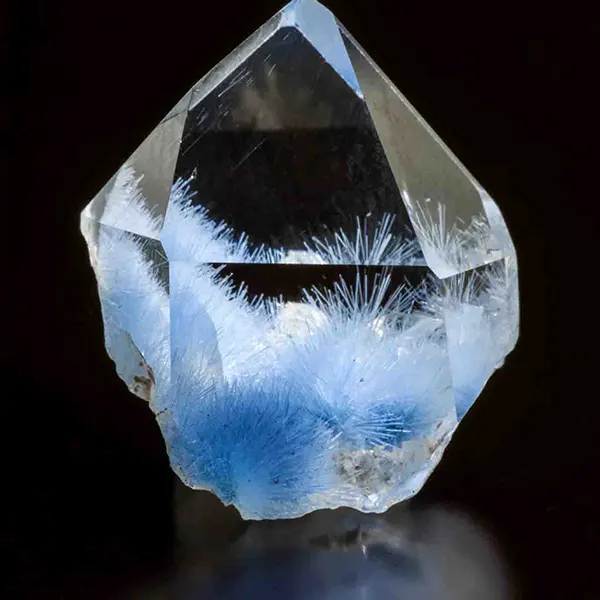
Clarity refers to the intrinsic architecture of inclusions within the gem or flaws on the stone’s surface. Inclusions in faceted gems are described as anything that interferes with the free movement of light. Small crystals of the same mineral, crystals of a different mineral, microscopic gas bubbles, tiny liquid-filled pockets, internal fissures or cleavages, or any other material that can be seen inside the stone can all be inclusions. These may develop as one or more crystals or form in small microscopic “clouds.” In the realm of gems, intensive scrutiny is the norm, so even seemingly slight flaws can cause price swings.
For diamonds
In contrast to colorful gemstones, where inclusions have less of an impact on value, diamond inclusions have a considerable impact on the value of a diamond. Because it is difficult to identify imperfections with the human eye due to the way a diamond reflects light internally, the Federal Trade Commission (FTC) suggests using a ten-power hand-held magnifier or microscope to assess the clarity of diamonds. Several grades are assigned to diamonds with flaws that are undetectable to the naked eye but have no effect on the stone’s beauty. The price difference, though, is significant.
For colored stones
Gemologists typically grade colored stones by noting whether they are “eye-clean” (i.e., free of apparent inclusions) or whether they are light, medium, or severely included. Eye-visible inclusions always reduce a gem’s value, but not by the same degree. Colored stones are divided into three clarity grades according to the GIA clarity grading system: “Type I,” which is typically eye-clean; “Type II,” which is often included; and “Type III,” which is virtually always included. Emeralds are an example of a gemstone in the Type III category.
You shouldn’t be too concerned about inclusions, though, as long as the aesthetic of the stone appeals to you and complements your wardrobe.
Cut
The topic of gemstone cutting has already been covered in depth. However, in this section, we will be going into a little more detail. Raw or untreated gemstones do not have the same visual appeal as those found in engagement rings and other jewelry. This is where cutting and polishing come into play; they symbolize the totality of craftsmanship that went into fashioning stones into the gorgeous, sparkling forms used in jewelry.
To assess the cut of your stone, inspect its symmetry. The more symmetrical a gem is, the better its light-reflecting capacity. Thus, for a faceted gemstone, observe from the sides and ends if your stone has bulges or is symmetrical in all directions.
However, this rule doesn’t apply to all stones, as some are intentionally cut into asymmetrical (freeform) shapes, so before making any conclusions, remember to double-check the designer’s intentions.
To assess the polish of your stone, inspect it under a magnifying lens. Although poorly polished stones could be obvious to the naked eye, be careful to double-check with a magnifying lens. Take note of the facets that reflect light. They ought to be shiny and mirror-like. A subpar polish is indicated by pits, scratches, or dull spots.
Carat
A carat is a unit of weight for gems. One carat is equal to one-fifth of a gram, or 200 milligrams. One kilogram (2.2 pounds) is equal to 5,000 carats.
Larger stones are rarer than smaller ones. As a result, they frequently demand a higher cost per carat. A higher gemstone carat count on a piece of jewelry typically translates into a higher price because more material was used to make it. However, smart design techniques and setups enable lower-carat pieces to punch above their weight, so this should not be the primary factor in deciding between products. For example, seven 1.6-mm diamonds set closely together will take up the same amount of space as a full-carat diamond. When set in white gold, it is difficult to tell the stones apart. As a result, these options are frequently referred to as “illusion settings.” While these seven stones have the aesthetic appeal of a one-carat diamond, they are merely 0.14 carats in weight. Considering that the price per carat for small diamonds is also much lower, you’ll see a significant cost difference. A cluster ring may cost hundreds of dollars, as opposed to thousands of dollars for larger stone jewelry.
Gemstone packaging
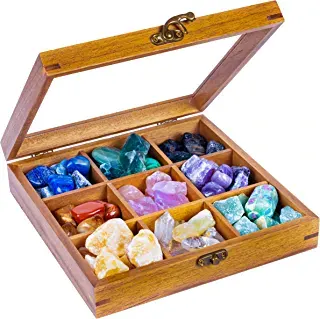
Your gemstone collection deserves to be kept safe and organized. You’ll not only find the items you’re looking for faster, but you’ll also keep them safe. Although that heap of precious stones appears luxurious, keep in mind that diamonds have varying hardness ratings and can scratch each other over time. Some gemstones are also vulnerable to environmental factors or chip quickly; therefore, they should not be left out in the open. Packaging is critical in the presentation, transportation, and storage of loose gemstones. The ideal loose gemstone packaging solution should integrate portability and utility. It should be light and compact, as well as safeguard the stones. Stones should be positioned face-up for easy viewing and in separate compartments to avoid chipping one another.
Importance of gemstone packaging
- Protection:
Using the right packaging strategy helps to ensure the safety of your stones from other stones and other potential threats that may cause them to lose their value.
- Presentation/displaying:
There are gemstone organizers with pull-out drawers available, as well as display cabinets with glass tops that allow you to display your gemstone collection.
- Transportation:
In this regard, the importance of gemstone packaging is more appreciated by wholesalers who stock hundreds or thousands of stones and are well aware of the higher costs involved with high-value shipping, as well as the challenges of portability and secure storage.
- Storage:
Another good reason to consider proper gemstone packaging is storage. Some gemstones are more sensitive to harsh environmental conditions than others, while others chip or scratch easily. Whatever the case may be, proper storage helps to prevent these occurrences.
Common types of boxes/solutions for packaging jewelry
- Plastic containers with dividers
- Parcel paper organizers
- Pull out drawers
- Display cases with glass covers
- Jewelry bags with foam inserts
- Gemstone jars with foam inserts
Key Takeaway
This article’s objective has always been to arm you with all the information you need as a gemstone aficionado or simply a curious person, as the case may be. You may be confident that you are no longer a novice when it comes to gemstones if you took the time to read this article cover to cover.
